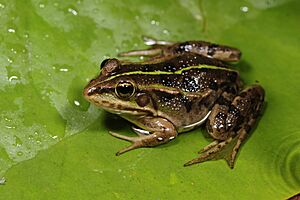Albanian water frog facts for kids
Quick facts for kids Albanian water frog |
|
|---|---|
 |
|
| Conservation status | |
| Scientific classification | |
| Synonyms | |
|
Hotz, Uzzell, Guenther, Tunner & Heppich, 1987 |
The Albanian water frog (Pelophylax shqipericus) is a type of true frog. It lives mainly in Albania and Montenegro. This frog loves water, as its name suggests. It lives in wet places like marshes and swamps.
Sadly, the Albanian water frog is an endangered species. Its numbers are going down. This is because its home is being polluted or drained. Also, people sometimes collect these frogs to sell them.
These frogs are medium-sized. Male frogs can have a bright green stripe down their back. They are usually green or light brown with dark spots. Female frogs are olive green or light brown. They also have brown or black spots. Their feet are fully webbed, which helps them swim well.
Contents
What is the Albanian Water Frog?
The Albanian water frog is a special kind of frog. It was first described in 1987. Its scientific name, shqipericus, comes from "Shqipëria." This is the Albanian word for Albania.
Scientists used to group many frogs, including this one, into the Rana genus. But with new DNA information, they learned more. They found that many frogs needed their own groups. So, the Albanian water frog was moved to the Pelophylax genus.
Where Do Albanian Water Frogs Live?
The Albanian water frog lives only in the Balkans. You can find it mostly in western Albania and southern Montenegro. It likes places with fresh water. These include marshes, swamps, and ditches. It also lives along the edges of lakes and rivers that have lots of plants.
One important place where it lives is Lake Skadar. This lake is in both Albania and Montenegro. However, too many frogs are being collected from this lake. This is a big threat to the frogs there.
What Do Albanian Water Frogs Look Like?
Male Albanian water frogs are about 71 mm (2.8 in) long. Their backs can be green or light brown. They have large brown or black spots. Sometimes, they have a bright green stripe down their back. During the breeding season, their spots might fade. Their color can also change to olive or grass green. Their throat sacs, which they use to call, are usually gray or green.
Female frogs are a bit bigger, about 74 mm (2.9 in) long. They are light brown or olive green. They also have spots on their backs. Their underside is often cream colored and has no spots. They might have yellow around their groin area. This yellow can sometimes spread to their back legs and belly.
Like many water frogs, their feet are fully webbed. The webbing goes all the way to the tips of their toes. This helps them swim very well. Both male and female frogs can make a distress call. This call lasts for several seconds.
Why Are Albanian Water Frogs Endangered?
The number of Albanian water frogs is going down. This is happening for a few reasons:
- Habitat Loss: Their homes are being destroyed. Wetlands are drained to build things or for farming. This breaks up the places where they can live.
- Pollution: The water in their habitat is getting dirty. This pollution comes from farms and factories. It flows into their lakes and swamps.
- Over-Collection: People collect these frogs too much. They are caught to be sold as pets or for food. This reduces the number of frogs in the wild.
Lake Skadar is a protected area. It is important for wetlands. But even there, frogs are still collected. This practice not only lowers the frog population but can also spread diseases. One serious disease is chytridiomycosis. It can also bring non-native frogs into the area.
Albanian water frogs need water to breed and for their young to grow. Scientists are not sure how well these frogs can adapt. They need to deal with these threats and changes in their environment.


